Scenario 3: Setting up a Development > Staging > Production Environment
Before

After
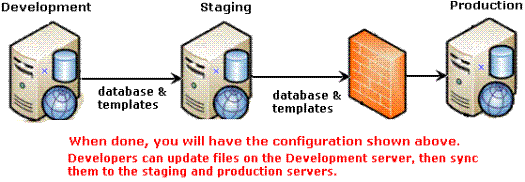
In this scenario, a version of Ektron CMS400.NET resides on one server. You will consider that your production server and use it to initialize the staging and development servers.
Warning! In this scenario, you cannot sync between the development and production servers. The sync can only be run between Development and Staging or Staging and Production.
Here’s a preview of the steps you will follow.
Part 1: Set up Min Site on Staging and Development Servers
Part 2: Generate and Copy Security Certificates
Part 3: Connect Staging and Production Servers
Part 4: Download Production Server Database to Staging Server
Part 5: Download Production Server’s Templates to Staging
Part 6: Connect Development and Staging Servers
Part 7: Download Staging Server Database to Development Server
Part 8: Download Staging Server Templates to Development
Prerequisite - See eSync Requirements
Part 1: Set up Min Site on Staging and Development Servers
1. Upgrade your existing server to the current version of Ektron CMS400.NET if necessary.
2. Install a minimum site on the staging and development servers.
3. To do this, run the Ektron CMS400.NET base installation file (CMS400Base8x.exe) version 7.6 or higher. (For more information, see Installing Ektron CMS400.NET.)
Part 2: Generate and Copy Security Certificates
Security certificates authorize synchronization between servers. In an eSync configuration, every server needs a security certificate from every other server, as shown below.
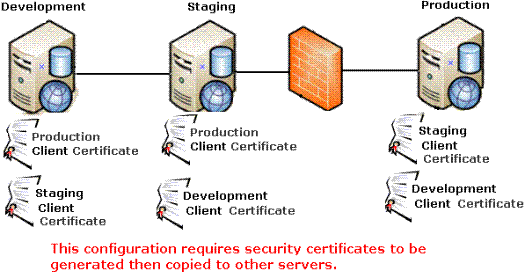
To generate and copy these certificates, follow these steps.
A. Generate Certificates on Production and Copy to Staging and Development
B. Generate Certificates on Staging and Copy to Development and Production
C. Generate Certificates on Development and Copy to Staging and Production
A. Generate Certificates on Production and Copy to Staging and Development
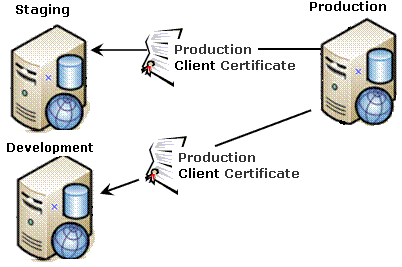
Follow these steps to complete this procedure.
1. Sign on to the production server.
2. Choose the Windows Start Button> All programs > Ektron > CMS400 v8x > Utilities > Security Configurator.
3. The following screen appears.
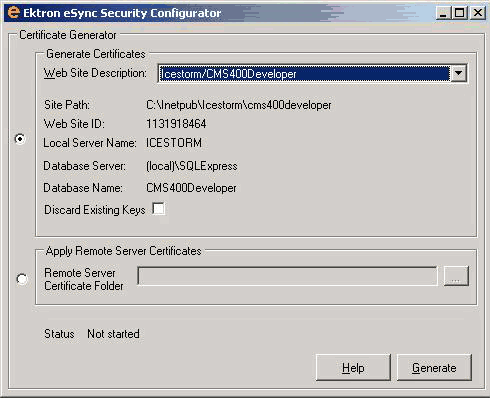
4. At the Web Site Description field, select the Web site on the production server.
5. Press Generate.
6. The certificates are created on the production server.
7. Open two Windows Explorer windows: one showing the production server’s file system, and the other showing the staging server’s file system.
8. In the staging server window, create a folder underneath the root folder. Name the folder Prod security certificates.
Warning! Do not create the new folder under the web root, C:\inetpub\wwwroot.
9. In the production server window, open the following folder: C:\ProgramFiles\Ektron\CMS400v8x\Utilities\Software\SecurityConfigurator.
10. From that folder, copy these files.
servername_SyncClient.pfx
servername_SyncClient.pvk
servername_SyncClient.cer
servername_SyncServer.pfx
servername_SyncServer.pvk
servername_SyncServer.cer
11. Paste the files into the folder you created in Step 9. Make sure there are no other security files in the folder.
12. Close both windows you opened in Step 8.
13. After copying the security certificate files to the staging folder, you need to register and move them to the correct folders. The Security Configurator screen does this.
14. Sign on to the staging server.
15. Open the security configurator screen using this path: Windows Start Button > All programs > Ektron > CMS400 v8x > Utilities > Security Configurator.
16. The security configurator screen appears.
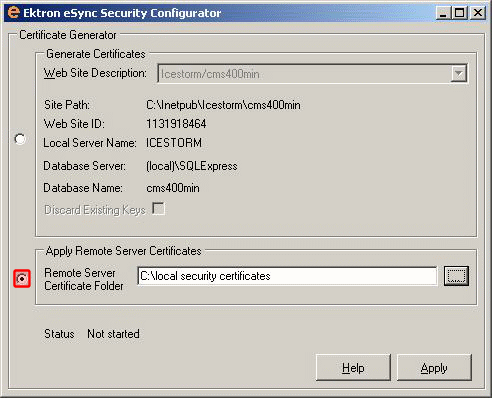
17. Click Apply Remote Server Certificates (circled above).
18. Click the browse button next to that field.
19. Browse to the folder to which you pasted the security certificates in Step 12.
20. Click Apply.
21. The security configurator copies the certificates you pasted in Step 12 to the correct folder, and configures them for the staging server.
22. Follow the same procedure to move production certificates to the development server. To do this, begin at Step 8 and follow all steps. Wherever the instructions mention a staging server, substitute the development server.
B. Generate Certificates on Staging and Copy to Development and Production
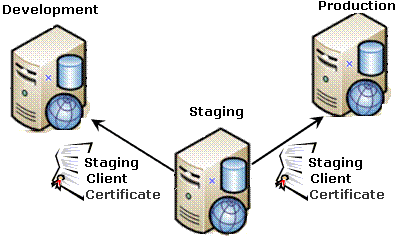
Follow these steps to complete this procedure.
1. Sign on to the staging server.
2. Choose Windows Start Button> All programs > Ektron > CMS400 v8x > Utilities > Security Configurator.
3. The following screen appears.

4. At the Web Site Description field, select the Web site on the staging server.
5. Press Generate.
6. The certificates are created on the staging server.
7. Open two Windows Explorer windows: one showing the staging server’s file system, and the other showing the production server’s file system.
8. In the production server window, create a folder underneath the root folder. Name the folder staging security certificates.
Warning! Do not create the new folder under the web root, C:\inetpub\wwwroot.
9. In the staging server window, open the following folder: C:\ProgramFiles\Ektron\CMS400v8x\Utilities\Software\SecurityConfigurator.
10. From that folder, copy these files.
servername_SyncClient.pfx
servername_SyncClient.pvk
servername_SyncClient.cer
servername_SyncServer.pfx
servername_SyncServer.pvk
servername_SyncServer.cer
11. Paste the files into the folder you created in Step 9. Make sure there are no other security files in the folder.
12. Close both windows you opened in Step 8.
13. After copying the security certificate files to the production folder, you need to register and move them to the correct folders. The Security Configurator screen does this.
14. Sign on to the production server.
15. Open the security configurator screen using this path: Windows Start Button > All programs > Ektron > CMS400 v8x > Utilities > Security Configurator.
16. The security configurator screen appears.

17. Click Apply Remote Server Certificates (circled above).
18. Click the browse button next to that field.
19. Browse to the folder to which you pasted the security certificates in Step 12.
20. Click Apply.
21. The security configurator copies the certificates you pasted in Step 12 to the correct folder, and configures them for the production server.
22. Follow the same procedure to move staging certificates to the development server. To do this, begin at Step 8 and follow all steps. Wherever the instructions mention a production server, substitute the development server.
C. Generate Certificates on Development and Copy to Staging and Production
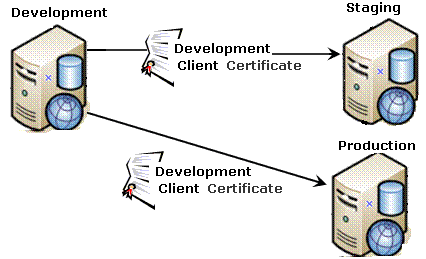
1. Sign on to the development server.
2. Choose Windows Start Button> All programs > Ektron > CMS400 v8x > Utilities > Security Configurator.
3. The following screen appears.

4. At the Web Site Description field, select the Web site on the development server.
5. Press Generate.
6. The certificates are created on the development server.
7. Open two Windows Explorer windows: one showing the development server’s file system, and the other showing the staging server’s file system.
8. In the staging server window, create a folder underneath the root folder. Name the folder Dev security certificates.
Warning! Do not create the new folder under the web root, C:\inetpub\wwwroot.
9. In the development server window, open the following folder: C:\ProgramFiles\Ektron\CMS400v8x\Utilities\Software\SecurityConfigurator.
10. From that folder, copy these files.
servername_SyncClient.pfx
servername_SyncClient.pvk
servername_SyncClient.cer
servername_SyncServer.pfx
servername_SyncServer.pvk
servername_SyncServer.cer
11. Paste the files into the staging server folder you created in Step 9. Make sure there are no other security files in the folder.
12. Close both windows you opened in Step 8.
13. After copying the security certificate files to the staging folder, you need to register and move them to the correct folders. The Security Configurator screen does this.
14. Sign on to the staging server.
15. Open the security configurator screen using this path: Windows Start Button > All programs > Ektron > CMS400 v8x > Utilities > Security Configurator.
16. The security configurator screen appears.

17. Click Apply Remote Server Certificates (circled above).
18. Click the browse button next to that field.
19. Browse to the folder you created in Step 9.
20. Click Apply.
21. The security configurator copies the certificates you pasted in Step 12 to the correct folder, and configures them for the staging server.
22. Follow the same procedure to move development certificates to the production server. To do this, begin at Step 8 and follow all steps. Wherever the instructions mention a staging server, substitute the production server.
Part 3: Connect Staging and Production Servers
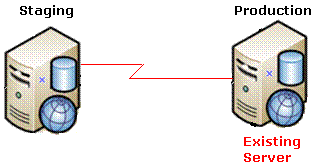
Warning! Back up your database before beginning this procedure!
1. On the staging server, sign on to Ektron CMS400.NET.
2. In the Ektron CMS400.NET Workarea, go to Settings > Configuration > Synchronization.
3. The View All Synchronization Configurations screen appears.

4. Click Add (
5. The Create Synchronization Server Relationship screen appears.
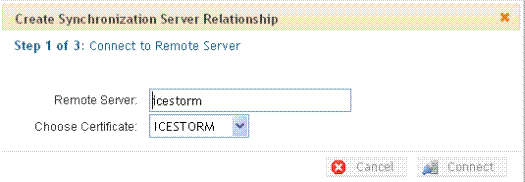
6. At the Remote Server field, enter the name of the production server.
7. At the Choose Certificate field, the name of the production server appears.
8. Click Connect. This action connects the staging with the production server.
9. After you connect to the production server, a new screen appears showing its database.

10. Click Next.
11. A new screen appears, showing both servers.
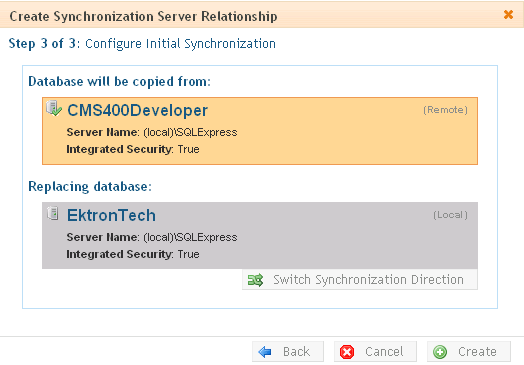
12. Click Create. This action connects the staging and production servers.
Part 4: Download Production Server Database to Staging Server

1. From the View All Synchronization Configurations screen, click Start Initial Sync (circled in the following figure).

2. The initial sync downloads the production server’s database to the staging server.
3. A screen tracks the sync’s progress.
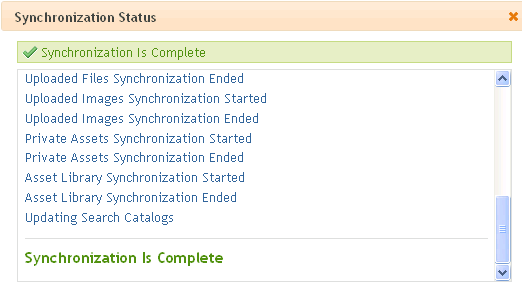
4. When the sync is complete, Synchronization is Complete appears.
The initial sync also creates a default database profile. The profile remembers information about the sync, such as the source and destination databases, sync direction, and the fact that it syncs the database and resource files (see example below). You can reuse this profile to run database/resource syncs any time in the future.
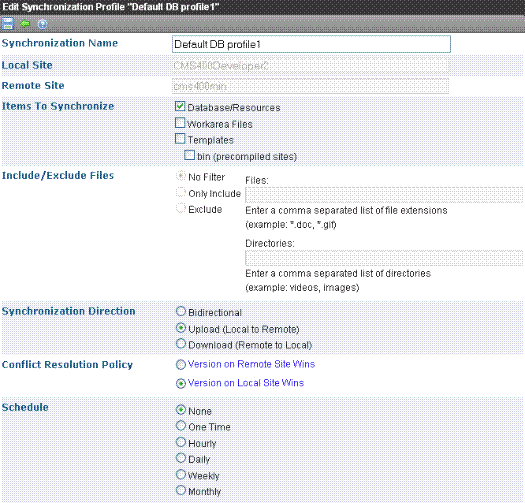
Part 5: Download Production Server’s Templates to Staging
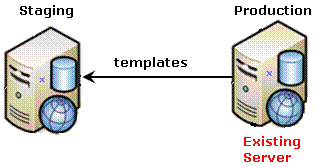
1. From the View All Synchronization Configurations screen, click Add Sync Profile.
2. The Add Synchronization Profile screen appears.
3. At the Synchronization name field, give this profile a name, such as Prod - Staging Template Sync.
4. At the Items to Synchronize field, select Templates.
5. For Direction, choose Download.
6. For Schedule, choose None. (See example below.)
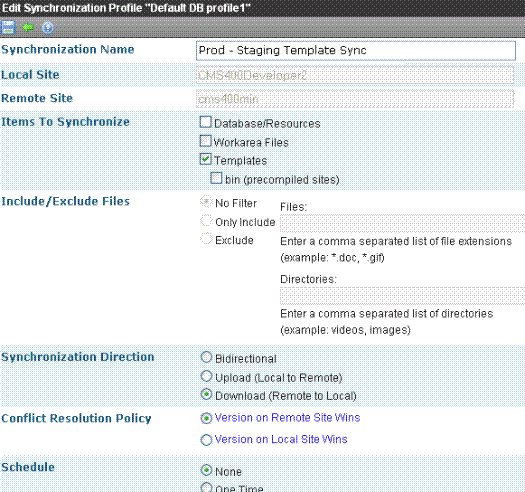
7. Save the profile.
8. Click Run to the right of the template sync (circled below).
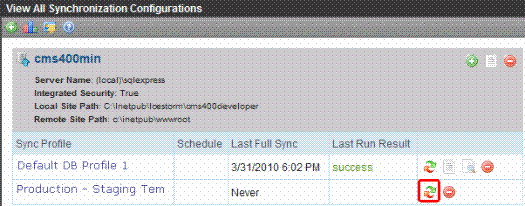
9. A screen tracks the sync’s progress.
10. When the sync is complete, Synchronization is Complete appears.
You can reuse the template sync profile to sync templates any time in the future.
Part 6: Connect Development and Staging Servers

1. Sign on to Ektron CMS400.NET development server.
2. In the Ektron CMS400.NET Workarea, go to Settings > Configuration > Synchronization.
3. The View All Synchronization Configurations screen appears.

4. Click Add (
5. The Create Synchronization Server Relationship screen appears.

6. At the Remote Server field, enter the name of the staging server.
7. At the Choose Certificate field, the name of the staging server appears.
8. Click Connect. This action connects the development with the staging server.
9. After you connect to the staging server, a new screen appears showing its database.

10. Click Next.
11. A new screen appears, showing both servers.

12. Click Create. This action connects the development and staging servers.
Part 7: Download Staging Server Database to Development Server
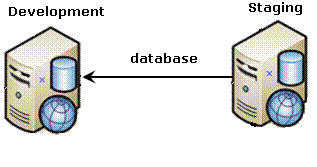
1. From the View All Synchronization Configurations screen, click Start Initial Sync.

2. The initial sync downloads the staging server’s database to the development server.
3. A screen tracks the sync’s progress.

4. When the sync is complete, Synchronization is Complete appears.
The initial sync also creates a default database profile. The profile remembers information about the sync, such as the source and destination databases, sync direction, and the fact that it syncs the database and resource files (see example below). You can reuse this profile to sync the database/resources between these two servers at any time in the future.

Part 8: Download Staging Server Templates to Development
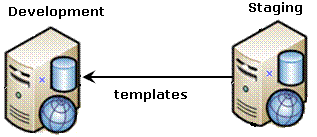
1. From the View All Synchronization Configurations screen, click Add Sync Profile.
2. The Add Synchronization Profile screen appears.
3. At the Synchronization name field, give this profile a name, such as Staging-Dev Template Sync.
4. At the Items to Synchronize field, select Templates.
5. For Direction, choose Download.
6. For Schedule, choose None. (See example below.)

7. Save the screen.
8. Click Run to the right of the template sync (circled below).
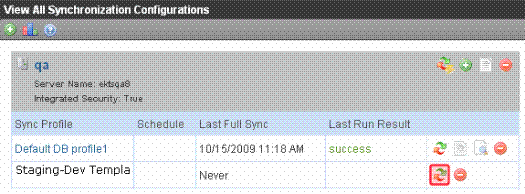
9. A screen tracks the sync’s progress.
10. When the sync is complete, Synchronization is Complete appears.
You can reuse the template sync profile to sync templates any time in the future.
